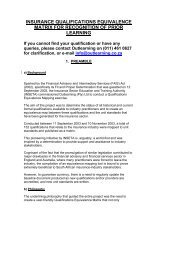SSP Brochure:Layout 1 - INSETA
SSP Brochure:Layout 1 - INSETA
SSP Brochure:Layout 1 - INSETA
You also want an ePaper? Increase the reach of your titles
YUMPU automatically turns print PDFs into web optimized ePapers that Google loves.
Healthcare fundersThe number of lives covered by medical schemes has remained stagnant over the past five years. The number of medical schemes,however, has declined due to consolidation and mergers, which, in turn, are the result of the quest for greater efficiency and betterrisk management. A factor that has impacted significantly on medical schemes is the outflow of skilled personnel (e.g. medicalpractitioners and nurses) from the medical provider subsector. The shrinkage of the private medical health sector has consequentlyrestricted the growth of healthcare funders. The overall growth of this subsector is also severely limited because of the unaffordabilityof medical cover to the majority of the population. A factor that may bring some new impetus to the subsector is the proposed newmedical scheme for government employees. This scheme is expected to bring uninsured employees into the system. 32Pension fundsThe pension fund system in South Africa is occupation-based, and therefore the growth of the pension fund subsector is closelylinked to the growth of formal employment in the country. As very little growth has occurred in formal employment over the pastdecade, pension fund membership has also grown slowly. In 1999, the FSB reported that the total membership of pension funds was9.1 million. The corresponding figure for 2004 was 9.9 million. However, the number of pension funds declined from almost 16 000funds in 1999 to 13 603 by the end of 2004. 33 The lack of growth in membership of pension funds will obviously inhibit growth inemployment in the fund administrators.IntermediariesNo statistical information is available on the economic performance of intermediaries. However, the professional bodies thatcontributed to the development of this <strong>SSP</strong> agreed that over the past few years a reduction had occurred in the business volume ofintermediaries in the short-term and the long-term subsectors. Various factors contributed to this situation:• The traditional (white) market has reached saturation point, and the white population group is not growing. The emerging (mainlyblack) market has not yet taken off.• Disintermediation – insurance companies (particularly in the short-term subsector) are bypassing the traditional broker networkand selling directly to the consumer. “Bankassurance” and retailers selling insurance and financial products directly to the consumerare also contributing to the bypassing of traditional brokers.The decline in the role of intermediaries is expected to continue in the foreseeable future. 34c) New and emerging marketsThe traditional market for insurance products (i.e. the high-income mainly white population) is saturated and the growth potentialof the market is therefore limited. Expansion of the industry is possible only through the exploration of the non-traditional lowincome (mainly black) market, which to date remains relatively untapped.Various reasons have been cited for the slow penetration and development of the emerging markets:• Insurance products that are not appropriate for the emerging markets (however, several participants in the <strong>SSP</strong> developmentprocess commented that the insurance companies are currently looking at the development of products that are more suitable forthe uninsured market).• Lack of consumer appreciation of the value and importance of insurance products.• Lack of consumer knowledge about financial planning and financial services.• Cultural and language barriers between potential clients and intermediaries.• Distribution channels for insurance products that are not relevant and affordable to the emerging markets.• The economic realities of a large proportion of the population, which compel people to spend their income on products otherthan insurance.The provision of insurance services to the lower income market is not only business imperative for the insurance sector, it is also partof the economic and social upliftment objectives to which the sector committed itself in the FSC. In response to the FSC requirementsthe long term and short term insurance subsectors each developed a set of minimum standards which guide the development ofspecific products for low income earners. The Zimele product standards, which were developed by the Life Offices Association(LOA) guarantee fair charges, easy access and decent terms for long term insurance policies. 35 The South African Insurance Association(SAIA) has developed a similar set of standards for short term insurance – the Mzanzi standards. 36d) Technological changeThe insurance industry is technologically advanced and uses sophisticated information systems. The past decade has seen technologicaladvances in most of the industry’s processes, for example product distribution and selling (e-selling and selling through call centres),client service and information, claims handling and administration.The technology used by the sector tends to stifle growth in employment as increasing volumes of work can be handled without32 BHF and Alexander Forbes Health Care Consultants, Key Performance Indicators from the 2004 Survey of Medical Schemes in Southern Africa and interview with representativesof the Board of Healthcare Funders.33 Membership includes active members, pensioners, deferred pensioners and dependants. People who belong to more than one pension fund are double counted in thestatistics. Sources: FSB, Annual Reports of the Registrar of Pension Funds, 2000 to 2005.34 PriceWaterhouseCoopers, Emerging Trends and Strategic Issues in South African Insurance, 2004.35 Interview with the CEO of the LOA, 2 August 2007.36 SAIA, Annual Review, 2007.<strong>INSETA</strong> Sector Skills Plan - page 12
















